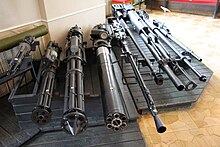
Back Canó rotatiu Catalan Cañón rotativo Spanish Kiertäväputkinen konetuliase Finnish Minigun French Arma a canne rotanti moderna Italian Meriam putaran Malay Roterende kanoner NB Оружие с вращающимся блоком стволов Russian Rotirajoči top Slovenian Роторна гармата Ukrainian


A rotary cannon, rotary autocannon, rotary gun or Gatling cannon, is any large-caliber multiple-barreled automatic firearm that uses a Gatling-type rotating barrel assembly to deliver a sustained saturational direct fire at much greater rates of fire than single-barreled autocannons of the same caliber. The loading, firing and ejection functions are performed simultaneously in different barrels as the whole assembly rotates, and the rotation also permits the barrels some time to cool. Rotary cannons, external or self-driven are used in aircraft over reciprocating bolt autocannons which are more prone to jamming in high g environments. The rotating barrels on nearly all modern Gatling-type guns are powered by an external force such as an electric motor, although internally powered gas-operated versions have also been developed.
The cyclic multi-barrel design synchronizes the firing/reloading sequence. Each barrel fires a single cartridge when it reaches a certain position in the rotation, after which the spent casing is ejected at a different position and then a new round is loaded at another position. During the cycle, the barrel has more time to dissipate some heat away to the surrounding air.
Due to the usually cumbersome size and weight of rotary cannon, they are typically mounted on weapons platforms such as vehicles, aircraft, or ships, where they are often used in close-in weapon systems.